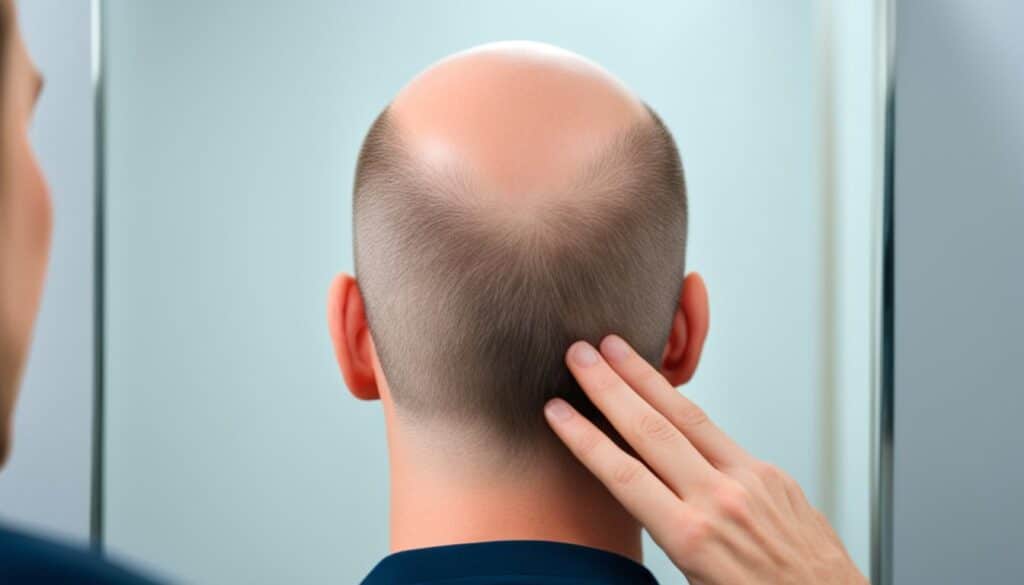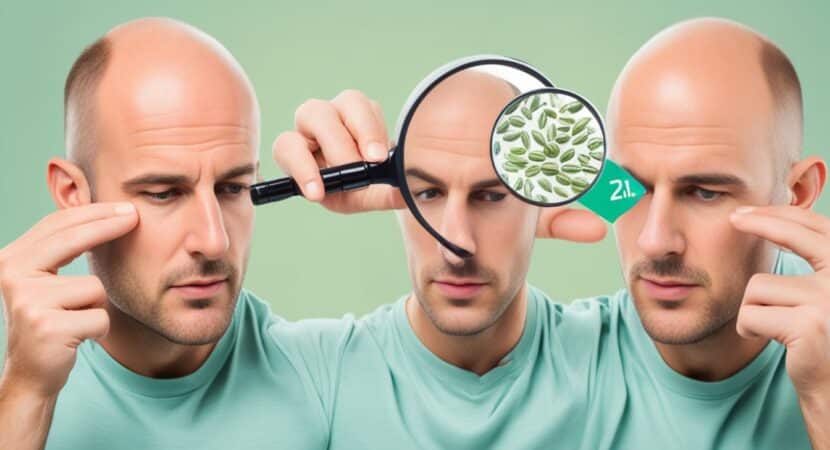Facing hair loss can be a distressing experience, but understanding that there are effective hair regrowth solutions available can offer a beacon of hope. Tackling baldness requires immediate action and the use of targeted treatments that promote rapid hair growth and overall hair restoration. This introductory guide aims to arm you with the knowledge and insights necessary to embark on a successful journey towards reclaiming a full head of hair with speed and confidence.
Whether you’re dealing with age-related thinning or sudden, patchy bald spots, various baldness treatments can help reverse the tide. There is no one-size-fits-all remedy, but by understanding the options, you can find an effective path to restore your hair’s vitality. So if you’ve noticed your hairline receding or bald patches forming, it’s time to explore the proven techniques and treatments that could revitalize your scalp’s landscape.
Key Takeaways
- Discovering early interventions for hair regrowth is crucial for effective treatment.
- It’s essential to identify the right hair regrowth solutions tailored to individual needs.
- Rapid hair growth can be achieved with a combination of treatments and lifestyle adjustments.
- Baldness treatment and hair restoration methods range from over-the-counter products to professional procedures.
- Staying informed on the latest advancements in hair regrowth can lead to better decision-making and results.
- Patient commitment to chosen treatments increases the likelihood of regaining a full and healthy head of hair.
Understanding Hair Loss: The Basics
Grasping the underpinnings of alopecia involves a dive into the myriad of hair loss causes and sifting through the cloud of hair loss myths that often mislead and frustrate individuals in search of honest answers. Bridging the gap between myths and facts requires an awareness of how the hair follicle cycle effects growth and, in turn, loss. With insights from dermatology and trichology experts, we’ll set the record straight and chart a course toward a better understanding of hair health.
Common Causes of Bald Spots
While baldness is often simplistically attributed to genetics, the reality is that factors such as hormonal imbalances, stress, nutrition, or even certain hairstyles can play significant roles in the onset of hair loss. From the temporary shedding experienced post-pregnancy, known as telogen effluvium, to the pattern baldness linked to androgenetic alopecia, each cause affects the hair in uniquely disruptive ways, warranting tailored approaches for treatment and management.
How Hair Growth Works
The journey of a single hair strand follows a natural ebb and flow known as the hair follicle cycle, comprising growth (anagen), transition (catagen), and rest (telogen) phases. Understanding this cycle can illuminate why certain strands may seem to fall out “prematurely” and how varying durations of these phases affect overall hair density and health. A disruption in this cycle can lead to conditions such as anagen effluvium, where the growth phase is cut short by factors like chemotherapy.
Myths vs. Facts About Hair Growth
Mythbusting is a crucial step towards effective hair restoration. It’s widely believed, for example, that frequent haircuts can accelerate growth, yet scientific research points to the indifferent nature of trimming where speed of growth is concerned. Another common belief is that stress has no real impact on hair health, despite direct links found between stress-induced hormones and hair loss. We’ll demystify these beliefs and more, presenting the pure facts grounded in science.
Preventative Measures to Protect Hair
In the endeavor of hair loss prevention, early actions not only mitigate the impact but can also enhance the vitality of your hair. Incorporating a healthy hair diet, implementing a thoughtful hair care routine, and steering clear of harmful hair products are cornerstone practices. Let’s delve into the essentials of safeguarding your hair’s health with a proactive approach.
Importance of Diet
Your hair’s health is significantly influenced by what you consume. A well-rounded diet rich in key vitamins and minerals provides the building blocks for strong, resilient hair. Vitamins such as biotin and vitamins A, C, E, alongside minerals like iron and zinc, play pivotal roles in hair growth and strength. Inclusion of these nutrients in your daily meals can support follicular health, promoting lush, vibrant hair.
Lifestyle Changes for Hair Health
Apart from diet, various lifestyle factors contribute substantially to the quality of your hair. Managing stress through activities like yoga or meditation can reduce the likelihood of stress-induced hair loss. Prioritizing sufficient sleep also aids in the repair and regeneration of hair cells, solidifying its role in a comprehensive hair care routine. The combined effect of these lifestyle adjustments offers a practical route to preserving hair density and vigor.
Products to Avoid
Many commercial hair care products contain chemicals that could potentially harm your hair. Ingredients such as sulfates, parabens, and phthalates are known to strip the hair of its natural oils and can lead to fragility and breakage. It’s imperative to make informed choices about the hair care products you use, opting for those that nourish and protect your hair. Below is a table outlining the contrasts between potentially harmful ingredients and safer alternatives:
| Harmful Ingredient | Effects on Hair | Safe Alternatives |
|---|---|---|
| Sulfates | Strips hair of natural oils, causing dryness and breakage | Sulfate-free cleansers |
| Parabens | Can disrupt hormonal balance and harm hair follicles | Natural preservatives like vitamin E |
| Phthalates | Potential to damage the hair structure | Fragrance-free or essential oil-scented products |
| Alcohol (in high concentrations) | May cause dehydration to the hair | Alcohol-free or low-alcohol formulas |
Embracing preventative measures anchored in nutrition, lifestyle choices, and thoughtful selection of hair care products, sets a solid foundation for combating hair loss and enhancing overall hair wellness.

How to Regrow Hair on Bald Spot Fast
When confronting the challenge of bald spots, individuals are often in search of fast hair regrowth techniques that can yield promising results. The current landscape of hair growth treatments encompasses a variety of methods, from topical solutions to advanced medical technologies promising hair loss reversal with varying degrees of speed and effectiveness. Highlighting the most advanced treatments can provide invaluable guidance for those desperate to see quick progress.
Over-the-counter medications, such as minoxidil, have long been the go-to choice for stimulating hair growth. While patient experiences vary, many individuals have observed significant hair regrowth with consistent application over several months. Prescription medications like finasteride can also deliver substantial improvements in hair density, particularly in cases of male and female pattern baldness. It’s important to consider these pharmaceutical options as part of a broader hair care strategy tailored to individual conditions.
“After six months of consistent treatment, I started to see noticeable improvements. It was a game-changer in my hair regrowth journey.” – Verified user of hair growth treatments.
In addition to the pharmaceutical approach, laser therapy is emerging as a formidable player in the arena of fast hair regrowth. Utilizing low-level laser therapy devices can stimulate follicles and enhance cell metabolism, a process that has warranted measured optimism among users. The convenience of home-use laser caps and combs has made this option increasingly popular among those seeking non-invasive treatments.
Surgical options, such as hair transplants, offer a more permanent solution. Techniques like Follicular Unit Transplantation (FUT) and Follicular Unit Extraction (FUE) have revolutionized the concept of hair restoration. Although costly and invasive, these procedures have proven effective, with the potential to completely reverse bald spots by transplanting one’s own hair to the affected areas.
Below is a comparative table highlighting the key attributes of these advanced hair regrowth techniques:
| Treatment | Type | Speed of Results | Efficacy |
|---|---|---|---|
| Minoxidil | Topical | Several Months | High for many users |
| Finasteride | Prescription Oral | Several Months to a Year | High for pattern baldness |
| Laser Therapy | Non-invasive Device | Varied, often months | Positive for many users |
| Hair Transplant | Surgical | Months to fully realize | Permanent, high efficacy |
The pursuit of restoring one’s hair can be fraught with uncertainty, but the advent of these hair loss reversal methods offers a silver lining. Testimonials and studies have provided sufficient evidence to demonstrate the potential of these treatments, making the dream of regaining a full head of hair an attainable reality for many.
Before embarking on any treatment for hair regrowth, it’s crucial to seek advice from healthcare professionals who can provide personalized recommendations based on one’s unique hair loss profile. By doing so, individuals can find the most effective, swift, and safe pathway to hair regrowth.
Natural Remedies and Their Efficacies
Turning to nature’s bounty, we find a treasure trove of natural hair growth remedies known for bolstering scalp health and encouraging hair regeneration. Simple yet potent, these solutions harness the intrinsic potency of essential oils and herbs, alongside kitchen staples, to revive lifeless strands and jumpstart your hair’s revival.
Essential Oils for Scalp Treatment
Essential oils such as rosemary and peppermint are not just pleasing to the senses; they are powerful allies in the quest for improved scalp health. Studies have linked rosemary oil to the same hair-growing effects as minoxidil, without the accompanying side effects. Peppermint oil, on the other hand, can cause a pleasant tingling sensation, signifying increased circulation that may lead to healthier hair growth.
- Rosemary oil: Enhances blood circulation and has been shown to promote hair growth.
- Peppermint oil: Known for its invigorating properties that may boost hair growth.
Herbal Supplements for Hair Regrowth
In the realm of hair regrowth herbs, saw palmetto and biotin stand out as noteworthy examples. Saw palmetto may help in blocking the enzymatic action that converts testosterone into DHT, a hormone associated with male pattern baldness. Biotin, a vitamin celebrated for its role in hair health, is an essential nutrient that helps to strengthen hair and could potentially aid in its regrowth when deficiency is addressed.
| Herb | Potential Benefit | How it Supports Hair Growth |
|---|---|---|
| Saw Palmetto | DHT Blocker | May prevent hair follicle shrinkage and loss |
| Biotin | Strengthening Agent | Essential for keratin production, improving hair structure |
Homemade Hair Masks and How to Apply Them
When it comes to DIY hair treatments, homemade hair masks are a thrifty and effective method for nourishing your mane. A popular concoction involves eggs, rich in protein, avocado, packed with healthy fats, and coconut oil for its deep moisturizing properties. To apply:
- Whisk together one egg, half a mashed avocado, and a tablespoon of coconut oil.
- Apply the mixture from roots to ends, ensuring complete coverage.
- Wrap your hair in a shower cap, allowing the mask to work its magic for at least 20 minutes.
- Rinse thoroughly with lukewarm water and follow with a gentle sulfate-free shampoo.
This mask can be your go-to for a regular infusion of hair-loving nutrients, encouraging strength and shine from within.

Conclusion
As we wrap up our comprehensive guide, your hair regrowth journey stands before you not as a path of uncertainty, but as one illuminated by a beam of hopeful strategies and success stories. We’ve explored the grounding science behind hair growth, previewed advanced treatments, and embraced natural remedies, all to equip you with a multifaceted arsenal against hair loss.
Remember, your quest for bald spot recovery and eventual hair growth success is not only about choosing the right products or treatments. It’s just as much about adopting a lifestyle that prioritizes scalp health, engaging in regular self-care that fosters an environment for growth, and maintaining a diet that supplies your hair with the nutrients it craves.

Through it all, patience and consistency remain critical companions on your trek to thicker, fuller hair. Recovering from hair loss is rarely an overnight feat—it’s a marathon, not a sprint. But take heart: each step forward is a stride towards not only restoring your hair but also rebuilding the confidence that comes with it.
“Embrace your hair regrowth journey with persistence and care, and the rewards will unfold in time.”
In the end, while this guide aims to steer you towards effective solutions, always consult with a healthcare professional before initiating any new treatment regimen. They can offer tailored advice, grounded in an understanding of your unique hair profile, to ensure that your path to recovery is both safe and soundly charted.
With the right approach, your narrative can transition from concern to triumph, as you write each new chapter of your hair’s history—thicker, stronger, and brimming with life.
Additional Resources and Support
Embarking on a journey to combat hair loss can stir up a mixture of emotions, ranging from anxiety to resolve. Finding the right kind of hair loss support is an essential component of this journey. Establishing connections with others who share similar experiences can be both comforting and enlightening. To this end, there are numerous online forums and support groups where individuals can find camaraderie and exchange valuable advice on coping with hair loss, discovering effective treatments, and boosting overall wellbeing during this challenging time.
Aside from community-based support, it’s equally important to seek professional guidance. Scheduling a consultation for hair loss with certified trichologists or dermatologists can provide a solid foundation for understanding your personal hair loss condition and tailoring a treatment that aligns with your specific needs. These professionals stay abreast of the latest advancements in hair care and can offer insights into the most innovative and effective treatments available. Numerous hair loss clinics also offer comprehensive services, from diagnostic assessments to advanced therapeutic options, ensuring that patients have access to best-in-class hair growth resources from the outset.
Dealing with hair loss is a deeply personal experience, yet no one should have to navigate it in isolation. Leveraging the wealth of knowledge and empathy available through support networks and professional services can transform a solitary struggle into a shared journey towards recovery and renewal. Let these resources be a guide and an assurance that a thriving community and expert care are well within reach.


Reply